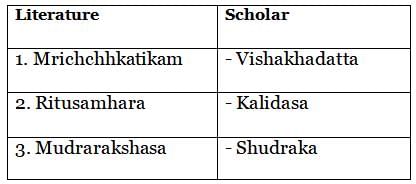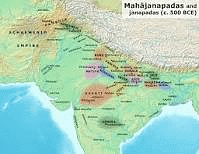JKPSC Prelims Paper 1 Mock Test - 1 - JKPSC KAS (Jammu and Kashmir) MCQ
30 Questions MCQ Test - JKPSC Prelims Paper 1 Mock Test - 1
Consider the following regions of ancient Indian history:
1. Kosala
2. Magadha
3. Gandhara
4. Avanti
5. Panchala
Which of the above was/were the ‘Mahajanapadas’?
What is the classification of the Himalayan Wolf according to the IUCN Red List?
Which event is commemorated on January 15th in India?
Who was honored with the IMMA Lifetime Achievement Award?
What significant event took place regarding the Maldives and India on January 15, 2024?
What historical significance does the date January 15 hold in 1759?
What is the estimated population range of the Himalayan Wolf?
Which notable figure is associated with the founding of Wikipedia?
What initiative is aimed at empowering youth-led startups in 2024?
What is the theme of the World Economic Forum Annual Meeting in Davos in January 2024?
Which Indian city hosted the Rahgeere Anand Utsav?
Which country did Croatia and Slovenia gain international recognition as independent nations in 1992?
What was inaugurated by PM Modi that is considered the longest sea bridge in India?
Sangam texts cover the social evolution of Tamil people. In this context, which of the following statements given below is/are not correct?
1. The narrative texts show that early Tamil people were primarily pastoral.
2. No reference to trade and economic activities has been made in these texts.
Select the correct answer using the code given below:
Consider the following statements:
Ajivikas were fatalists who believed that everything was predetermined.
Lokayatas were materialists who rejected the authority of the Vedas.
Makkhali Gosala was an Ajivika teacher and Ajita Kesakambalin was a lokayata teacher.
Which of the statements given above is/are correct?
Which of the following steps were taken by rulers in the medieval times to earn support of their subjects?
Declaring their close relationship with god through titles like “Shadow of God”.
Constructing public buildings like markets and water tanks.
Offering patronage to the learned and pious people.
Select the correct answer using the code given below.
Consider the following statements regarding Sultan Mahmud of Ghazni
- He entrusted a scholar, Al-Biruni to write an account of the subcontinent.
- Sultan Mahmud of Ghazni was a contemporary of Rajendra I.
- The Chahamana ruler Prithviraja III defeated an Afghan ruler named Sultan Mahmud of Ghazni.
Which of the statements given above are correct?
With reference to the Indus Valley Civilization, which one of the following statements is not correct?
With reference to Medieval India, consider the following pairs :

Q. How many pairs given above is/are correctly matched?
Consider the following pairs with reference to the cultural History of India :

How many pairs given above is/are correctly matched ?
Which of the following statements is/are correct about the currency reforms of Muhammad-Bin-Tughlaq?
1. Token currency was introduced for the first time ever in the history during his reign.
2. He introduced a bronze coin with the same value as the silver tanka.
Select the correct answer using the code given below:
In the context of mural paintings in ancient India, consider the following statements:
1. Paintings at the Kanchipuram temple were patronised by the Pallavas.
2. Paintings at Jaina caves in Sittanavasal were patronised by the Pandyas.
3. Mural painting as an art declined during the reign of the Cholas.
Which of the statements given above is/are Correct?
He was popularly called ‘Danka Shah’. In 1857, he was jailed in Faizabad. When released, he was elected by the mutinous 22nd Native Infantry as their leader. He fought in the famous Battle of Chinhat.
With reference to the difference between Civil Disobedience Movement and Non- Cooperation Movement, consider the following statements:
The Civil Disobedience Movement had the objective of Purna Swaraj, while Non- Cooperation Movement had the objective of Swaraj.
Muslim participation was relatively lesser during the Non-Cooperation Movement when compared to the Civil Disobedience Movement.
Which of the statements given above is/are correct?
Which of the following is/are the reasons for increased quest for and discovery of a sea route to India in 15th Century by European Nations?
Obsession of Prince Henry of Portugal to find India.
Red sea trade route was monopolised by Islamic rulers.
The art of ship building and navigation had made great advances in Europe.
Select the correct answer using the code given below:
Which of the following are included in the Gandhi-Irwin Pact of 1931?
Public inquiry into police excesses during civil disobedience movement
Immediate release of all political prisoners not convicted of violence
Right to peaceful picketing
Select the correct answer using the code given below.
Consider the following statements regarding Anglo Portuguese Treaty of Whitehall, 1661:
1. King Charles II as part of the dowry received Bombay through this treaty when he married Princess Catherine de
Braganza of Portugal.
2. It involved a mutual defence pact against the French East India Company.
Which of the statements given above is/are correct?
With reference to the British India, the Punjab Land Alienation Act, 1900 was passed to
In the context of the development of education during British India, arrange the following education commissions/ committees in chronological order of their establishment.
1. Hunter Education Commission
2. Sadler University Commission
3. Hartog Committee
Select the correct answer using the code given below.















